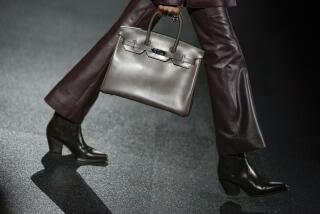Hermes Going Strong After 5 Generations
- Share via
NEW YORK — Jean-Louis Dumas-Hermes is president of Hermes, the company founded by his great-great-grandfather, Thierry Hermes, 150 years ago.
But he is neither the eldest great-great-grandson, nor the one who expressed the most interest in the family luxury-goods business, which is known around the world among the well-to-do.
“It isn’t,” he said with an engaging smile, “a kingdom.”
Now, at 49, Dumas-Hermes is the standard-bearer of the business, which makes more than 6,000 items, including silk scarfs and ties, fine leather saddles, handbags and refillable date books.
During this 150th anniversary year, he traveled to San Francisco, Lyon, Milan and Munich, where new stores designed by his architect wife Rena were added to the existing 49 stores and 189 outlets in Europe, America, Australia, Japan, Singapore and Hong Kong.
Boutiques opened this year in San Antonio, Denver and Manhasset, Long Island.
“We are booming up in this country,” he said during a visit to the Manhattan store. “Last year was double from 1985. It is exciting.”
But, as a young man, he wasn’t so sure about the opportunities the family business offered.
“At the time I was 25 I felt very far from Hermes as a business,” he said.
Working for People
“When my father insisted I would enter Hermes, I remember very well my reaction. I went to see an uncle who was a judge and asked him for advice. He said, ‘Do you want to work for people or for money?’
“I said, ‘I want to work for people.’ You can’t answer any other way when you’re young.”
“He said, ‘You can do this at Hermes.’ ”
After a brief stint in the United States, where he worked for Bloomingdale’s and his wife was employed by an architectural firm, Dumas-Hermes returned to Paris to enter the family business--but not at the top.
“My father sent me to auctions. He said, ‘Maybe you can pick up a few ideas for our designers of scarfs.’ I felt a little shameful, sent just to find a few motifs.”
In 1971, Dumas-Hermes said, “My father turned to me in front of others and suggested I become managing director of Hermes. I was taken by surprise. . . . The family voted me chairman in 1978.”
Family members still own 90% of company stock. Two cousins, Patrick Guerrand and Bertrand Puesch, are vice chairmen.
A few days before he died, Dumas-Hermes’ father, Robert Dumas, company president, had said to him, “You should be the one after me.”
“We had never talked about it,” said Dumas-Hermes. “We had discussed a lot about the future of the company. My concern was to blow on the fire, to keep it going. What was important was the company. The importance was never me.
“We have the feeling that if we conduct the business badly and lose our clientele, we will be replaced by nothing similar. If you’re in charge of an airline company and you sell, there will be another airline. People will always want to fly from New York to Chicago. There is no one working with silk, silver, leather and perfume the way we do. We don’t say it is superior. We say it is our way.”
Not ‘Luxury’ Goods
Thierry Hermes established himself, in 1837, as wholesale harness maker to the Champs-Elysees coach builders. He also did special orders for royalty. His son, Emile-Charles Hermes, following him, added retail sales of saddles, harnesses and curry combs.
His son, Emile-Maurice Hermes, bought out a brother and took over, bringing in golf accessories, handbags, accessories for the new motorcars, like trunks to strap on the back, and the statement that Hermes “specialized in travel, sports and a tradition of refined elegance.”
Dumas-Hermes doesn’t describe the products his company sells as luxury goods. He talks instead about fine materials, the dedication of craftsmen and the durability of high-quality items.
“There is an ability of man to take time to create products which last more than one man’s life,” he said.
All product designing and all leather work is done above the Hermes store in Paris. It takes an average of 48 hours to make a suitcase, 23 hours to make a saddle, 15 hours to make a handbag.
Scarves a Big Seller
One craftsman makes one piece, from beginning to end, then stamps it with the date and his or her number. If that item is returned to an Hermes outlet for repair, it is sent to Paris and--if the maker hasn’t retired--repaired by the person who made it. Many of the craftsmen are children and grandchildren of Hermes craftsmen.
The company buys raw Chinese silk and, in a plant near Lyon, France, spins it, makes cloth in a heavy, tight weave, prints the colors and makes clothing, jockeys’ silks, ties and scarfs--often with equestrian motifs.
Scarfs and ties, which sell for $140 and $65 respectively, are Hermes’ biggest sellers.
“In 1837, we were only selling to kings and a very few rich people.
“Now there are less kings and rich people and many more people well-to-do,” Dumas-Hermes said.
Dumas-Hermes has a son and a daughter, neither working in the business. Among their generation of cousins, the oldest is 28. Again, no heir to head the business has been designated.
Said Dumas-Hermes: “Maybe the one to follow me hasn’t been born yet.”
More to Read
Inside the business of entertainment
The Wide Shot brings you news, analysis and insights on everything from streaming wars to production — and what it all means for the future.
You may occasionally receive promotional content from the Los Angeles Times.








